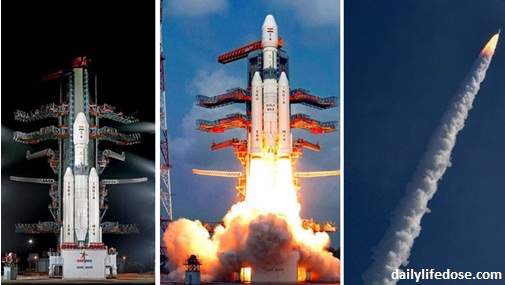On Monday evening 5th June, India has launched it’s one more heavily invention that named GSLV Mk-III rocket. This launch vehicle M-III is developed by the Indian Space Research Organization at Satish Dhawan Space Center.
It is much like a 200 full grown Asian elephants or such like five jumbo jets. GSLV MK-III weighs of 640 tones and gives extensive features of the Indian cryogenic third stage and comes with higher payload capacity.
After the successful launch, ISRO is looking forward to making a way to space for a human. Various tests and experiments will be conducted on this rocket. Further, through this invention, various critical technologies will be developed for the ISRO’s named mission. After the two failures in 2010, it is the second mission of the GSLV rocket.
Do You Know?
Recently, a heavy lift launch vehicle is invented by the ISRO that named GSLV Mk III which includes specifications:
- Height
This heavy rocket is standing by the total height of 43.43 m.
- Vehicle Diameter
The total diameter of this vehicle is about 4.0 m.
- Heat Shield Diameter
A Heat Shield (Payload Fairing) of this rocket included a diameter of 5.0m.
- Number of stages
ISRO has launched a three-stage heavy lift in which it includes two solid strap-ons, a core liquid booster, and a cryogenic upper stage.
- Liftoff Mass
It can lift a mass of 640 tonnes.
TOP 11 SMARTWATCHES TO OWN IN 2017
What are the various features of GSLV Mk-III rocket?
It is the kind of three stage vehicle which consist of indigenous cryogenic upper stage engine. This engine is designed in such a way that it can carry heavier communication satellites into the Geosynchronous Transfer Orbit (GTO). It is built in with 28 tonnes of propellants with two solid S200 strap-on motors and with an L110 core liquid booster. With its successful invention, GSLV Mk-III rocket has the capability to carry large payloads. These payloads can weigh up to 4,000 kg in GTO to 10,000 kg to Low Earth Orbit. GSAT-19 is powered with the indigenously-made lithium-ion batteries. These strongly built batteries are helpful in increasing the India’s self-reliance quotient. These essential batteries are also used to power the electric vehicles like cars and buckets. GSAT-19 is extensively featured with certain advanced spacecraft technologies that include a miniaturised heat pipe, fibre optic gyro, and Micro-Electro-Mechanical Systems accelerometer. These all requirements are tested for the future missions.
10 Facts about the GSLV Mk-III rocket
It is one of the heaviest rocket which ever made by India before. Due to its high capacity of carrying large payloads, it also provides various other benefits. The following are the list the very first 10 facts about the GSLV Mk-III rocket. These facts are the successful developments that come in this heavy engine.
Fact 1. High Capacity to carry heavy payloads
The GSLV Mk-III can carry payloads up to 4,000 kg into the GTO that is known as Geosynchronous Transfer Orbit and 10,000 kg into the Low Earth orbit. GSLV Mk III has a powerful cryogenic stage which enables it to place heavy payloads into LEO of 600 km altitude.
Fact 2. Potential to launch big satellites
This rocket is equal to the weight of the fully loaded Jumbo Jets or can be compared with the 200 fully grown Asian Elephants. GSLV-Mk III has the full capacity to launch satellites that weigh up to four tonnes in the Geosynchronous Transfer Orbit (GTO).
LATEST INNOVATION OF FUTURE TECHNOLOGY
Fact 3. Enhance the telecommunication areas
It is one of the fully functional rockets which are tested with the cryogenic engine. These engines use the various liquid propellants such like liquid oxygen and liquid hydrogen. Due to this fact, this satellite is aimed at improving the telecommunication as well as broadcasting areas of the country.
 GSLV Mark-III rocket at the cryogenic stage inside a preparation facility
GSLV Mark-III rocket at the cryogenic stage inside a preparation facility
Fact 4. Powered by Lithium-ion Batteries
GSAT-19 is powered with the indigenously-made Lithium-ion batteries. These batteries have increased the India’s Self-reliance quotient. It’s similar batteries are used to power the electric vehicles such like cars and buses.
Fact 5. Advanced Spacecraft Technologies
GSLV Mk-III is the best to build in with the advanced spacecraft technologies. These include a miniaturised heat pipe, a fibre optic gyro, micro-electro-mechanical systems (MEMS) accelerometer, as well an indigenous lithium-ion battery.
Fact 6. Powered with indigenous cryogenic engine
This heavily built rocket is powered by an indigenous cryogenic engine which makes use of oxygen and liquid hydrogen as propellants. C-25 is powered by the CE-20 which is one of the largest cryogenic engines and is designed by the Liquid Propulsion Systems Centre.
THE NEXT GENERATION ACTION CAM
Fact 7. launched the strong Component
On Feb 18, 2017, ISRO has successfully launched the strongest component of the vehicle. The component named C-25, which is the upper stage of the GSLV. Finally, ISRO has successfully ground-tested the development of C-25.
Fact 8. offers solid built-in component
GSLV-Mk III is strongly built with the two S200 solid motors strap-ones, one L110 liquid propellant core stage and with a C-25 cryogenic stage. This L110 liquid stage is powered by two Vikas engines designed and developed at the Liquid Propulsion Systems Centre. It comes with the total height of 21m and diameter of 4m. Moreover, GSLV Mk III uses two S200 solid rocket boosters in order to provide the huge amount of thrust. S200 solid rocket boosters were developed at Vikram Sarabhai Space Centre.
Fact 9. Developed Critical Technologies
The Indian space agency has already developed critical technologies for a human space mission. The space suit is ready and a crew module was tested in 2014.
Fact 10. Carry people into space
It is mentioned that if GSLV Mk-III rocket clears all the tests, it will be the India’s first vehicle to carry people into space.
Hence, this achievement had made the whole nation to feel proud. This launch will surely provide a path for many people to travel into space. So, wait and watch the coming new more facts about this rocket machine.












